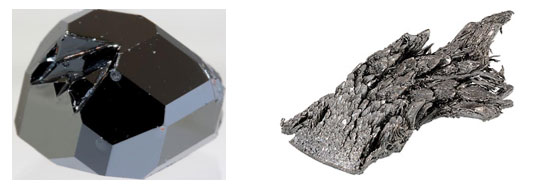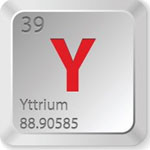Introduction to Yttrium Element
Yttrium is the rare earth transition metal located in group number 3 and period 5 of the periodic table. Its atomic number is 39 whereas its atomic mass is 88.90. There are 39 electrons in a single neutral atom of yttrium.
The nucleus of the yttrium contains 39 protons and 50 neutrons. The element yttrium is represented by the symbol “Y”.
Naming and History
Yttrium was named after the valley Ytterby in Sweden from where it was discovered.
- Carl Arrhenius
In 1787, Carl Arrhenius found coal-like material in quartz near Ytterby valley in Stockholm – the capital of Sweden. He thought he had found a new mineral of tungsten as he reported that the mineral contain iron and tungsten. He named it Ytterbite.
- Johan Gadolin
He sent the specimen to Johan Gadolin in Finland. In 1794, he carried out a detailed analysis and concluded that it contained 12% iron oxide, 19% alumina, 31% silica, and 38% unknown earth material.
- Anders Ekeberg
In 1797, another Swedish chemist Anders Ekeberg confirmed the observations and results of Gadolin. He suggested the name Yttria for the unknown rare earth transition metal which later became Yttrium.
- Frederick Wohler
In 1828, Frederick Wohler first isolated the yttrium metal by reacting yttrium oxide with potassium.
- Carl Mosander
In 1843, Carl Mosander investigated the oxides of yttrium and found three oxides. These were yttrium, terbium and erbium oxides.
- Frank Spedding
In 1953, Frank Spedding produced yttrium metal of high purity by using ion exchange techniques.
Occurrence of Yttrium
Yttrium never exists as a free element in nature. It is present in minerals and ores of rare earth metals. Some yttrium is present in uranium ores. Today, most of the yttrium is obtained by the process of ion exchange from monazite sand. Monazite is a mineral rich in rare earth elements.
The other yttrium containing minerals are barnasite, fergusonite, and samarskite.

Properties of Yttrium
Yttrium is soft, highly crystalline, silverish- gray rare earth transition metal. Its compounds are mostly colorless but oxides are yellow, white, and other colors. It usually exists as a trivalent ion Y 3+. It has a high affinity for oxygen.
It is fairly stable in the air due to the formation of thin oxide film on its surface. It oxidizes on heating. Yttrium reacts with mineral acids. In reaction with water, it decomposes it eliminating hydrogen plus forming yttrium hydroxide.
Finely divided yttrium is very unstable in the air and easily ignites. The melting point of yttrium is 1522°C and its boiling point is 3345°C. It has a density of 4.47 grams per cubic centimeter and exists as solid at room temperature.
Yttrium in Biological Systems
There is no known significant role of yttrium in living systems. Its salts are soluble and mildly toxic.
Uses of Yttrium
- Metallic yttrium is not widely used but its compounds are of good importance.
- Yttrium compounds are used to produce red phosphor which is used in color televisions.
- Yttrium is used in aluminium and magnesium alloys to increase their strength.
- Yttrium aluminium garnet (YAG) is used in specific lasers which cut through the metals.
- It is used in LED lights for white color.
- It is used in making microwave filters for radar for blocking certain frequencies and is widely used in communication devices and satellites.
- Yttrium is alloyed with chromium and aluminium to make heat-resistant metal.
- It is used as a catalyst in ethylene polymerization.
- Yttrium barium copper oxide is of great importance and is used in the production of high-temperature super conductors and conducts electricity without any loss of energy.
- Yttrium oxide is used in the manufacturing of camera lenses and a special type of heat and shock-resistant glass.
Isotopes of Yttrium
From mass numbers 79 to 103, almost 25 isotopes of yttrium are known for their half-lives. Yttrium- 89 is the only naturally occurring stable isotope.
- The radioactive isotope of yttrium – Yttrium- 90 is used in the diagnosis and treatment of various cancers. It is used in precise medical needles to sever pain-transmitting nerves in the spinal cord.
MCQs:
- 1. What is the atomic number of yttrium?
- A) 39
- B) 50
- C) 88.90
- D) 12%
- Answer: A) 39
- 2. What is the symbol of yttrium?
- A) Yb
- B) Yt
- C) Y
- D) Ym
- Answer: C) Y
- 3. Who confirmed the observations and results of Johan Gadolin regarding yttrium?
- A) Carl Arrhenius
- B) Frederick Wohler
- C) Carl Mosander
- D) Anders Ekeberg
- Answer: D) Anders Ekeberg
- 4. How was yttrium first isolated as a metal?
- A) By reacting yttrium oxide with potassium
- B) By chemical precipitation
- C) By electrolysis
- D) By distillation
- Answer: A) By reacting yttrium oxide with potassium
- 5. What is the primary source of obtaining yttrium today?
- A) Uranium ores
- B) Ion exchange from monazite sand
- C) Barnasite
- D) Fergusonite
- Answer: B) Ion exchange from monazite sand
- 6. What is the color of yttrium oxide?
- A) Green
- B) Yellow
- C) Blue
- D) Red
- Answer: B) Yellow
- 7. Which property of yttrium makes it fairly stable in the air?
- A) High melting point
- B) Formation of thin oxide film on the surface
- C) High reactivity with oxygen
- D) Low boiling point
- Answer: B) Formation of thin oxide film on the surface
- 8. What is the melting point of yttrium?
- A) 3345°C
- B) 1522°C
- C) 20°C
- D) 0°C
- Answer: B) 1522°C
- 9. What is the primary use of yttrium compounds in color televisions?
- A) Increase in strength of alloys
- B) Production of red phosphor
- C) Making heat-resistant metal
- D) Creation of LED lights
- Answer: B) Production of red phosphor
- 10. What role does yttrium play in the production of YAG lasers?
- A) Increase in strength
- B) Coloration
- C) Heat resistance
- D) Cutting through metals
- Answer: D) Cutting through metals
- 11. Which isotopes of yttrium are known for their half-lives?
- A) Yttrium-79 to Yttrium-103
- B) Yttrium-50 to Yttrium-88
- C) Yttrium-12 to Yttrium-39
- D) Yttrium-1 to Yttrium-25
- Answer: A) Yttrium-79 to Yttrium-103
- 12. What is the only naturally occurring stable isotope of yttrium?
- A) Yttrium-88
- B) Yttrium-50
- C) Yttrium-89
- D) Yttrium-90
- Answer: C) Yttrium-89
- 13. What is the primary use of yttrium-90 in medical applications?
- A) Treatment of cancer
- B) Creation of heat-resistant metal
- C) Production of LED lights
- D) Manufacturing of camera lenses
- Answer: A) Treatment of cancer
- 14. Who is credited with the discovery of yttrium?
- A) Carl Arrhenius
- B) Johan Gadolin
- C) Anders Ekeberg
- D) Frederick Wohler
- Answer: A) Carl Arrhenius
- 15. Which mineral is rich in yttrium and other rare earth elements?
- A) Uranium ores
- B) Monazite sand
- C) Barnasite
- D) Fergusonite
- Answer: B) Monazite sand
- 16. What is the atomic mass of yttrium?
- A) 39
- B) 50
- C) 88.90
- D) 12%
- Answer: C) 88.90
- 17. What role does yttrium play in aluminium and magnesium alloys?
- A) Increases strength
- B) Enhances color
- C) Improves conductivity
- D) Provides stability
- Answer: A) Increases strength
- 18. What is the color of yttrium compounds?
- A) Mostly black
- B) Mostly colorless
- C) Mostly yellow
- D) Mostly red
- Answer: B) Mostly colorless
- 19. Who first isolated yttrium as a metal?
- A) Johan Gadolin
- B) Carl Arrhenius
- C) Frederick Wohler
- D) Carl Mosander
- Answer: C) Frederick Wohler
- 20. Which element was yttrium initially mistaken for by Carl Arrhenius?
- A) Iron
- B) Tungsten
- C) Uranium
- D) Titanium
- Answer: B) Tungsten
- 21. What is the density of yttrium?
- A) 4.47 grams per cubic centimeter
- B) 3345°C
- C) 1522°C
- D) 39
- A) 4.47 grams per cubic centimeter
Summary
The tutorial delves into the exploration of yttrium, an intriguing rare earth transition metal occupying group 3 and period 5 of the periodic table. Boasting an atomic number of 39 and an atomic mass of 88.90, yttrium is distinguished by its 39 protons and 50 neutrons within the nucleus, symbolized by “Y.”
Naming and History: Yttrium owes its name to the Swedish valley of Ytterby, where it was discovered in the late 18th century. Through the endeavors of notable chemists like Carl Arrhenius, Johan Gadolin, Anders Ekeberg, and others, yttrium’s properties and isolation as a metal were gradually unveiled.
Occurrence: Yttrium primarily occurs in rare earth minerals, notably monazite sand, and plays a vital role in various applications. Other yttrium-containing minerals include barnasite, fergusonite, and samarskite.
Properties: Yttrium is soft, highly crystalline, with a silverish-gray appearance. Its compounds are mostly colorless, but its oxides exhibit various colors. Yttrium usually exists as a trivalent ion (Y3+) and is fairly stable in the air due to the formation of a thin oxide film on its surface.
Uses: Yttrium finds extensive applications, from producing red phosphor for color televisions to strengthening aluminum and magnesium alloys. It is utilized in lasers, LED lights, communication devices, and high-temperature superconductors. Yttrium oxide is used in manufacturing camera lenses and heat-resistant glass.
Isotopes: Yttrium possesses numerous isotopes, including the naturally stable Yttrium-89 and the radioactive Yttrium-90, which finds applications in medical diagnostics and treatments.
While yttrium lacks a defined biological role, its diverse applications underscore its importance across industries, making it a versatile and valuable element in the scientific and technological landscape.

